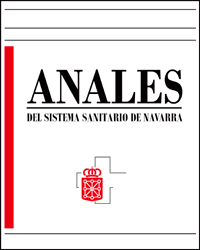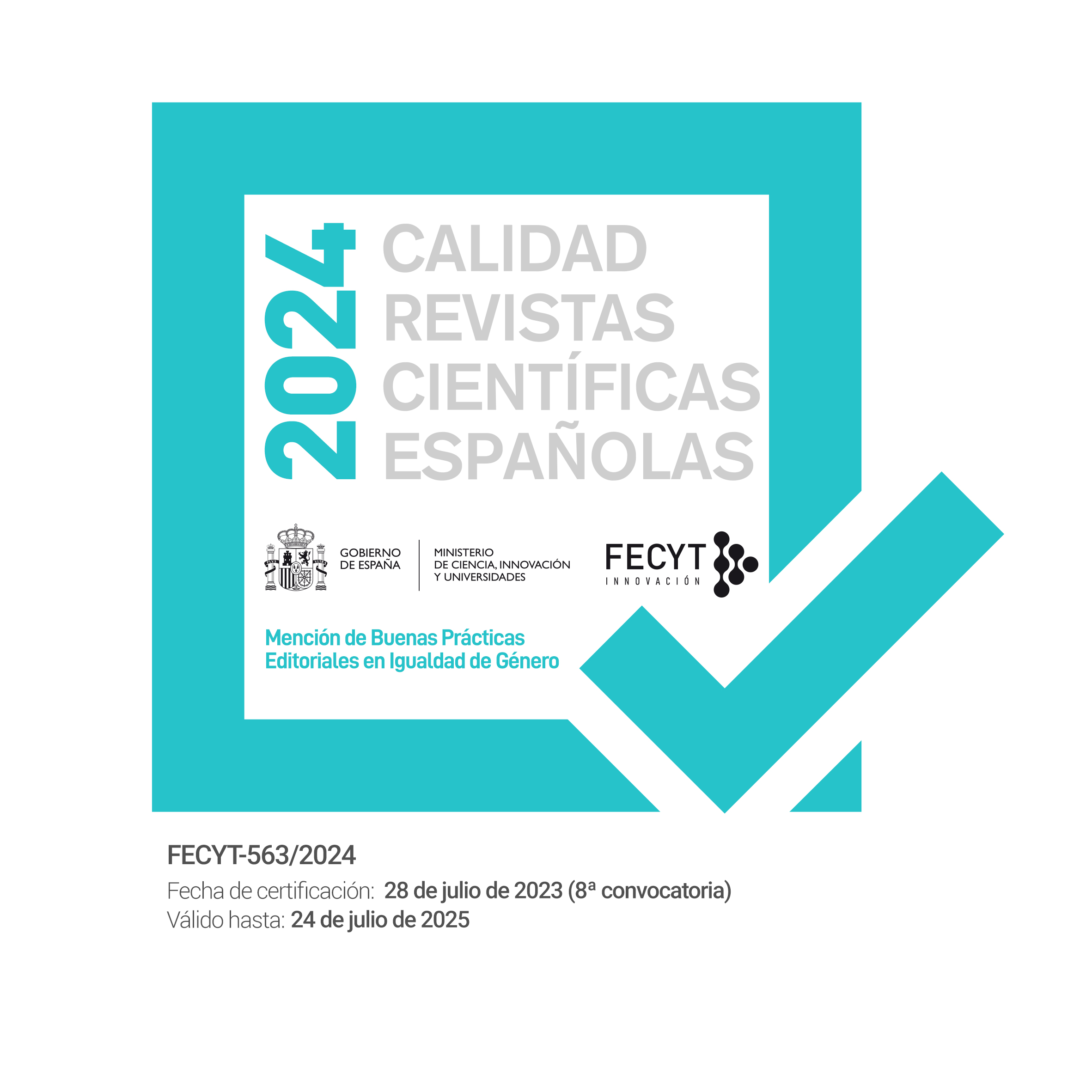Parálisis de cuerda vocal unilateral: estudio de la calidad vocal después del tratamiento logopédico
DOI:
https://doi.org/10.23938/S1137-6627/2016000100008Palabras clave:
Parálisis de cuerda vocal unilateral. Tratamiento logopédico.Resumen
Fundamento. Describir los factores sociodemográficos de pacientes con parálisis de cuerda vocal unilateral (PCVU) a los que se aplica un tratamiento logopédico y analiza el impacto en la calidad vocal tras la terapia.
Metodología. Se incluyeron 47 pacientes con PCVU diagnosticada mediante vídeo-laringoscopia. Todos recibieron intervención logopédica repartida en 15 sesiones y estructurada en tres etapas progresivas. Se instruyó al paciente en técnicas vocales, coordinación fono-respiratoria, control del soplo, tonificación glótica e impostación vocal. Los parámetros incluidos en el estudio antes y después de la terapia fueron: cierre glótico, Voice Handicap Index-10 (VHI-10) para medir la autopercepción de calidad vocal y escala GRABS para la calidad vocal.
Resultados. La edad media fue 51 años (rango 20-80), 60% mujeres. La causa quirúrgica fue la más frecuente (72%). El 40% desempeñaban una profesión relacionada con la voz. El tiempo medio desde el diagnóstico hasta el inicio del tratamiento fue 5 meses (2-12). El cierre glótico completo aumentó de34 a 80% (p<0,001), la puntuación en VHI-10 descendió de24,24 a 16,09 puntos (p<0,001) y los valores de GRABS mejoraron en todas las cualidades de la voz (p<0,001). Solo un 8,5% requirió cirugía post-tratamiento.
Conclusiones. La terapia de reeducación vocal es eficaz como primera indicación terapéutica en pacientes con PCVU, reservando la medialización con material no reabsorbible o cirugía de tiroplastia a aquéllos con mala evolución. No obstante, es necesario reducir el tiempo que se demora el paciente en llegar ala Unidad de Voz tras el diagnóstico laringoscópico.
Palabras clave. Parálisis unilateral de cuerda vocal. Tratamiento logopédico.
Descargas
Citas
1. DEJONCKERE PH, BRADLEY P, CLEMENTE P, CORNUT G, CREVIER-BUCHMAN L, FRIEDRICH G et al. A basic protocol for functional assessment of voice pathology, especially for investigating the efficacy of phonosurgical treatments and evaluating new assessment techniques. Eur Arch Otorhinolaryngol 2001; 258: 77-82.
https://doi.org/10.1007/s004050000299
2. YUMOTO E, OYAMADA Y, NAKANO K, NAKAYAMA Y, YAMASHITA Y. Three dimensional characteristics of the larynx with immobile vocal cord. Arch Otolaryngol Head Neck Surg 2004; 130: 967-974.
https://doi.org/10.1001/archotol.130.8.967
3. PARNELL FW, BRANDENBURG JH. Vocal cord paralysis: a review of 100 cases. Laryngoscope 1970; 80: 1036-1045.
https://doi.org/10.1288/00005537-197007000-00002
4. NETTERVILLE JL, KORIWCHAK MJ, COUREY MS, WINKLE M, OSSOFF RH. Vocal fold paralysis following the anterior approach to the cervical spine. Ann Otol Rhinol Laryngol 1996; 105: 85-91.
https://doi.org/10.1177/000348949610500201
5. HIRANO M, FUJITA M, TANAKA S, FUJITA H. Vocal cord paralysis caused by esophageal cancer surgery. Ann Otol Rhinol Laryngol 1993; 102: 182-185.
https://doi.org/10.1177/000348949310200304
6. TITCHE L. Causes of recurrent laryngeal nerve paralysis. Arch Otolaryngol 1976; 102: 249-261.
https://doi.org/10.1001/archotol.1976.00780100045002
7. RAMADAN HH, WAX MK, AVERY S. Outcome and changing cause of unilateral vocal cord paralysis. Otolaryngol Head Neck Surg 1998; 118: 199-202.
https://doi.org/10.1016/S0194-5998(98)80014-4
8. SULICA L. The natural history of idiopathic unilateral vocal fold paralysis: evidence and problems. Laryngoscope 2008; 118: 1303-1307.
https://doi.org/10.1097/MLG.0b013e31816f27ee
9. TERRIS D, ARNSTIN D, NGUYEN H. Contemporary evaluation of unilateral vocal cord paralysis. Otolaryngol Head Neck Surg 1992; 107: 84-90.
https://doi.org/10.1177/019459989210700113
10. MISONO S, MERATI AL. Evidence-based practice evaluation and management of unilateral vocal fold paralysis. Otolaryngol Clin N Am 2012; 45: 1083-1088.
https://doi.org/10.1016/j.otc.2012.06.011
11. DEJONCKERE PH, OBBENS C, DE MOOR GM, WIENKE GH. Perceptual evaluation of dysphonia: reliability and relevance. Folia Phoniatr 1993; 45: 76-83.
https://doi.org/10.1159/000266220
12. NÚÑEZ-BATALLA F, CORTE-SANTOS P, SEÑARI-GONZALEZ B, LLORENTE- PENDÁS JL, GÓRRIZ- GIL C, SUAREZ-NIETO C. Adaptación y validación del índice de incapacidad vocal (VHI-30) y su versión abreviada (VHI-10) al español. Acta Otorrinolaringol Esp 2007; 58: 386-392.
https://doi.org/10.1016/S0001-6519(07)74954-3
13. ROSEN C, LEE AS, OSBORNE J, ZULLO T, MURRY T. Development and validation of the voice handicap index-10. Laryngoscope 2004; 114: 1549-1556.
https://doi.org/10.1097/00005537-200409000-00009
14. FANG TJ, LEE LA, WANG CJ, LI HY, CHIANG HC. Intracordal fat assessment by 3 dimensional imaging after autologous fat injection in patients with thyroidectomy induced unilateral vocal cord paralysis. Surgery 2009; 146: 82-87.
https://doi.org/10.1016/j.surg.2009.02.005
15. CHRISTOPOULOS A, SALIBA I, PÉLOQUIN L, AHMARANI C. The adjustable laryngeal implant. J Voice 2001; 15: 141-150.
https://doi.org/10.1016/S0892-1997(01)00014-5
16. REITER R. BROSCH S. Laryngoplasty with hyaluronic acid in patients with unilateral vocal fold paralysis. J Voice 2012; 26: 785-791.
https://doi.org/10.1016/j.jvoice.2011.11.007
17. HEUER RJ, SATALOFF RT, EMERICH K, RULNICK R, BAROODY M, SPIEGEL JR et al. Unilateral recurrent laryngeal nerve paralysis: the importance of "preoperative" voice therapy. J Voice 1997; 11: 88-94.
https://doi.org/10.1016/S0892-1997(97)80028-8
18. KELCHNER LN, STEMPLE JC, GERDEMAN E, LE BORGNE W, ADAM S. Etiology, pathophysiology, treatment choices, and voice results for unilateral adductor vocal fold paralysis: a 3-year retrospective. J Voice 1999; 13: 592-601.
https://doi.org/10.1016/S0892-1997(99)80013-7
19. D'ALATRI L, GALLA S, RIGANTE M, ANTONELLI O, BULDRINI S, MARCHESE MR et al. Role of early voice therapy in patients affected by unilateral vocal fold paralysis. J Laryngol Otol 2007; 24: 1-6.
https://doi.org/10.1017/S0022215107000679
20. MATTIOLI F, BERGAMINI G, ALICANDRI-CIUFELLI M, MOLTENI G, LUPPI MP, NIZZOLI F et al. The role of early voice therapy in the incidence of motility recovery in unilateral vocal fold paralysis. Logoped Phoniatr Vocol 2011; 36: 40-47.
https://doi.org/10.3109/14015439.2011.554433
21. SCHINDLER A, BOTTERO A, CAPACCIO P, GINOCCHIO D, ADORNI F, OTTAVIANI F. Vocal improvement after voice therapy in unilateral vocal fold paralysis. J Voice 2008; 22: 113-118.
https://doi.org/10.1016/j.jvoice.2006.08.004
22. MILLER S. Voice therapy for vocal fold paralysis. Otolaryngol Clin N Am 2004; 37: 105-119.
https://doi.org/10.1016/S0030-6665(03)00163-4
23. GIOVANNI A, OUAKNINE M, GARREL R. Physiologie de la phonation. Encyl Méd Chir Paris: Elsevier SAS; 2003: 20-632-A-10.
24. CHEN X, WAN P, YU YM, LI M, XU Y, HUANG P et al. Types and timing of therapy for vocal fold paresis/paralysis after thyroidectomy: a systematic review and meta-analysis. J Voice 2014; 28: 799-808.
https://doi.org/10.1016/j.jvoice.2014.02.003
25. MATTIOLI F, MENICHETTI M, BERGAMINI G, MOLTENI G, ALBERICI MP, LUPPI MP et al. Results of early versus intermediate versus delayed voice therapy in patients with unilateral vocal fold paralysis: our experience in 171 patients. J Voice 2014; doi: 10.1016/j.jvoice.2014.09.027.
Publicado
Cómo citar
Número
Sección
Licencia
Derechos de autor 2016 Anales del Sistema Sanitario de Navarra

Esta obra está bajo una licencia internacional Creative Commons Atribución-CompartirIgual 4.0.
La revista Anales del Sistema Sanitario de Navarra es publicada por el Departamento de Salud del Gobierno de Navarra (España), quien conserva los derechos patrimoniales (copyright ) sobre el artículo publicado y favorece y permite la difusión del mismo bajo licencia Creative Commons Reconocimiento-CompartirIgual 4.0 Internacional (CC BY-SA 4.0). Esta licencia permite copiar, usar, difundir, transmitir y exponer públicamente el artículo, siempre que siempre que se cite la autoría y la publicación inicial en Anales del Sistema Sanitario de Navarra, y se distinga la existencia de esta licencia de uso.








